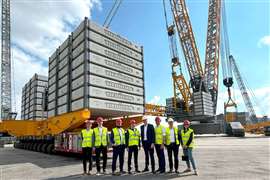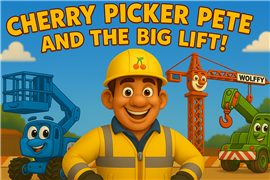Q&A with Dan Slater
06 January 2014
.jpg)
For a manufacturing facility that was built in the 1940s, Terex Waverly looks good and operates more efficiently than ever. Much of the reason for the recent success of the Iowa plant can be attributed to its transformation to lean manufacturing. And much of the success of this evolution can be found with the team led by Dan Slater, vice president and general manager, Terex Cranes.
For more than 20 years Slater has been involved with learning and implementing the lean process, mainly in the automotive industry, including Toyota, BMW and Volkswagen. Before being recruited to Terex seven years ago, he was president of a consulting company that specialized in lean transformation for all industries.
“Continuous improvement will be a term that will come up often when talking about lean, and is essentially a never-ending journey,” he said.
Through the years, as productivity increased and costs decreased in Waverly, Slater’s role has widened. Today he is responsible for commercial strategy, operations and profit and loss for Terex Cranes in North America.
“This means that besides being responsible for the production of Terex Cranes in Waverly, I am responsible for sales, support (service and parts) for all products in North America, no matter where in the world it was manufactured,” he explained.
Slater is pleased with the look, feel and culture now apparent at the Terex Waverly plant.
“When we take customers to the plant, we know we are going to get the sale,” he said with a smile. “You can immediately infer the quality of a product that comes out of these production lines.”
You have long been involved in implementing the Lean Manufacturing strategy. What is the evolution of implementing this strategy at Terex Waverly?
Lean is a culture, something that permeates the whole organization, a mindset. In order for lean implementation to work, it has to be supported by all team members. This means that team members have to be committed to it, and for it they have to believe in lean and realize that they can make a difference. For this, we’ve focused on four phases of lean transformation: foundational, stability, lean process and reduce waste.
Over the last few years, we have been working on developing a strong foundation. This means adding processes that will sustain productivity, quality and on-time delivery, as well as getting the whole organization up to speed with lean, essentially sparking a change in culture.
Processes that are foundational are not only related specific to the manufacturing process (Andon line, work flow, efficient standard work, etc.) but also on improvement processes such as how to tackle and solve issues, encourage and implement suggestions for improvement and the like.
Continuous improvement relies on team members for this to happen; they are the ones that know their work the best, so this foundational aspect aims to create an organization that encourages and allows improvement to happen.
We have a strong foundation now at Waverly. Now we are focusing on maintaining the stability to allow the loops of lean and waste reduction to run. Continuous improvement is a loop: improve, establish and do it again.
The key to this evolution is to implement the systems and to involve everyone on using the systems. This involves training and cultural change. Another key aspect is the discipline of maintaining the systems.
What areas of improvement are you most proud of?
Transforming the 1945-era Waverly plant into a world class manufacturing site. Walking through the manufacturing plant, the difference is amazing, and you can see it immediately. Of course this involves multiple processes and areas, and I can’t mention one single area that makes me proud. But walking through the production floor and firstly seeing how clean, efficient and smooth [it runs], makes me feel proud of what we have achieved.
Another thing that makes me proud is that it is constantly changing, evolving, improving, and that is proof that the implementation is working. Just recently we had the whole lighting of the plant changed into a very efficient system for example.
How do you see 2014 playing out in terms of crane demand?
I expect a stable year with an opportunity to gain marketshare with our products.
What are the hottest markets for cranes in North America? What crane models/classes are in the highest demand?
In terms of industry, oil and gas will continue to be a key industry, specifically the Gulf Coast petrochemical industries. Other areas of interest are the Keystone Pipeline and other pipelines out of Canada, as well as refineries in Mexico.
In terms of classes, the focus is on higher tonnage cranes in rough terrain, crawler and all-terrain markets. For the rough terrain crane, it’s the 80-ton capacity and above market. For the all-terrain crane, it’s the 140-ton capacity and above. There’s an uptick in the crawler market in the 110 to 275-ton capacity range and also in the higher classes as well.
Which machine produced at Waverly are you most excited about?
I am very excited about the Quadstar 1100, which has new features that will enhance the customer experience; hydraulic systems that will reduce fuel consumption with new EPA engines; and the new Terex family cab. Traditionally, rough terrain cranes from all manufacturers have been relatively behind other type of cranes in terms of operator comfort, accessibility and the like. The Quadstar 1100 changes all this, and is, in my opinion the most comfortable, user-friendly RT out there, and of course, with a strong capacity.
What is your business philosophy?
My philosophy is the Terex philosophy: Reduce complexity, improve customer product support, and be easier to do business with.
My philosophy to support that is to produce products efficiently with high quality by standardizing processes and teaching team members the elimination of waste through continuous improvement and think ‘customer first’ at all times.
It seems a cliché phrase, but in the crane industry it is dead simple: if a crane does not help a customer to be profitable, then they won’t purchase it. So we go to great lengths to make sure we understand what makes a profitable crane for our customers.
Wastes: there are multiple wastes (overproduction, waiting times, transportation and handling, excess inventory, wastes in production processes, useless motions and wastes from scrap and defects.) The thing with these wastes is that they do not add value to the end product. So by improving and eliminating waste, we get a value chain that goes straight to the end product.
What is it you like about the crane business?
It’s an exciting industry – large equipment, great products, machines that can lift the world. What’s not to like? Is also like a big family. It’s all about relationships and we know each other.
What keeps you engaged in your day-to-day job?
Seeing results and improvement from our teams. It gives immense pleasure to see the positive change that stays, and even greater to see that it comes autonomously from team members.
Not a day that goes by that you can’t improve design, quality and safety. The biggest draw that I like about this job, it’s the opportunities. The opportunity to make Terex a better company with our products and with our people. Knowing that we have so much available skill sets here that we can do anything we want to. Talented people, great product and a wonderful company to work for.
What do you do in your leisure time?
Golf! I love to golf. And I like to play with my French bull dog Cooper.
STAY CONNECTED


Receive the information you need when you need it through our world-leading magazines, newsletters and daily briefings.
CONNECT WITH THE TEAM











